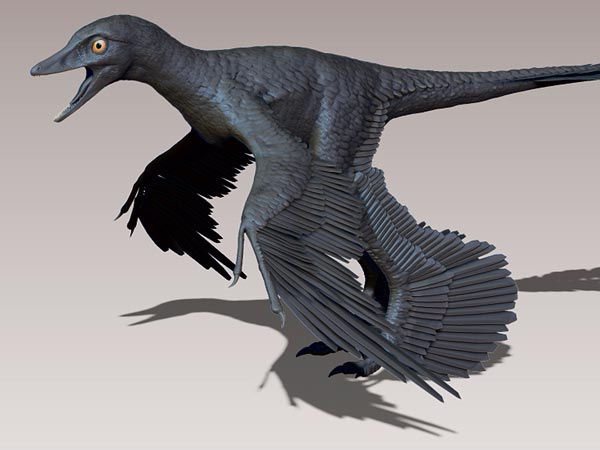Dragon-Like, Feathered Dinosaur Was Ace Flyer
Microraptor's aerodynamic wings are seen in an artist's reconstruction.
Why would a dinosaur with a body built for running have four wings and a long, feathered tail—and how did it use them? Paleontologists have long puzzled over the dragon-like anatomy of the tiny, carnivorous dinosaur called Microraptor that hunted in the forests of China 130 million years ago.
Finally, anatomists think they've found an answer: This crow-size dromaeosaur was a master of control. Whether it was gliding or flapping through the air, its hind wings would have let it turn on a dime.
"In terms of aerodynamics, the hind wings would have increased its rate of turn by 33 to 50 percent, compared to using only the front wings," said Michael Habib of the University of Southern California, Los Angeles, who co-presented the research at an annual meeting of the Society of Vertebrate Paleontology in Raleigh, North Carolina, last month.
Habib's collaborator, Justin Hall of the Natural History Museum of Los Angeles County, noted that even a small increase in turning speed would have been a "massive advantage" in Microraptor's eat-or-be-eaten world.
"No one's going to argue that this was the fastest animal in the ecosystem," Hall said.
"This was an animal about the size of a crow, living among predatory dinosaurs at a time when the largest animal in the air had a 15-foot [4.6-meter] wingspan! So, a 33-percent increase in turning speed could have meant the difference between life and death."
Strange Anatomy
Microraptor's long, narrow front wings suggest it was capable of flapping or gliding flight. Yet its short, blocky hind wings—which would have created more drag than lift in the air—seem to contradict that idea. But Habib and Hall argue that perhaps lift wasn't the point.
"If you were trying to use those blocky hind wings to glide, they would be very poor at that," said Habib. "But if you care more about a very rapid, powerful motion such as turning than you do about sustained motion, being 'draggy' is fine."
Hall compared the dinosaur's flight with canoeing: "When you're trying to turn a canoe quickly, often the best thing to do is to stick the paddle down in the water and produce a lot of drag."
There are three main rotational forces that affect flight, explained Habib: Yaw (side to side), roll (circular), and pitch (up and down). The size and location of Microraptor's hind wings would have increased all of these, but only yaw and roll would have helped it turn. So what about the problem of extra pitch, which could lead to an unintended nose dive?
"It turns out that the fan of feathers on the tail is in exactly the right place to correct for the hind wings' pitch," said Habib.
The Origin of Flight
Questions about Microraptor's anatomy are tied to an even bigger one in evolutionary history: Which came first, the flight or the height? In other words, did ground-dwelling dinosaurs evolve into fliers and then start living in the trees, or vice versa?
Microraptor was a cousin of the fearsome Velociraptor, and though small, it was also a fierce predator. Mammalian bones were found in the stomach of one specimen, and an entire bird—apparently swallowed whole—in another.
"It was eating very active prey," said Hall, "things that we would typically associate with being fast-moving or agile animals."
The fact that Microraptor ate birds suggests that it spent at least part of its time in trees. But the question of how much time is still up in the air. Did it use its wings to glide, or to initiate Parkour-style leaps from the ground? Either way, said Habib, control would have been important.
"Whether it was was an arboreal animal or more of a terrestrial animal, our argument applies equally well in either scenario," he said.
The idea that hind wings dramatically increased turning speed might also provide insight into how some modern birds of prey use their legs in flight, the researchers noted.
"Why do eagles stick out their legs when they fly? It looks weird, right?" said Hall. "Well, they have a lot of feathers on those legs, so they're producing a lot of drag. It leads to the implication that they're doing it intentionally, for control."
With very few feathers in the fossil record—they don't preserve as well as bones—it's hard to draw any definite conclusions about exactly how and when dinosaurs evolved into birds. But Habib and Hall think Microraptor's body plan could represent an intermediate step in that process.
"We can not say for sure at this time," said Habib. "But it's plausible that this is an alternative answer to the question of how birds evolved."
Amanda Fiegl
National Geographic News
Published November 5, 2012












